Vietnam Helos
HR2S/CH-37C "DEUCE"
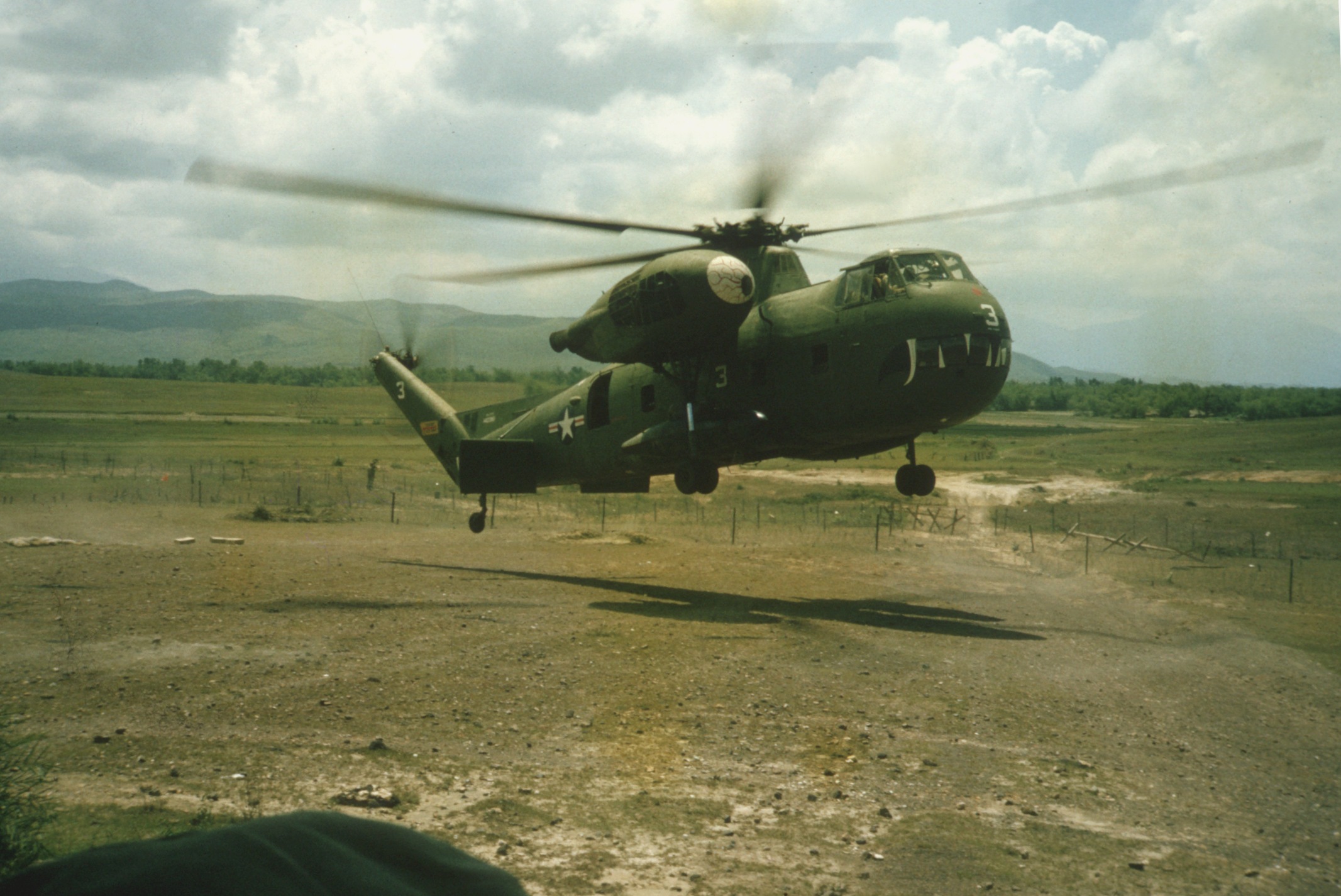
| TYPE | MFGR. | POWERPLANT | WEIGHT EMPTY | WEIGHT MAXIMUM | PERFORMANCE MAX SPEED | INITIAL CLIMB RATE | SERVICE CEILING | COMBAT RADIUS |
|---|---|---|---|---|---|---|---|---|
| CH-37 | Sikorsky | TWO (2,100-hp) Pratt & Whitney R-2800-54 piston engine | 19,704 lb. | 28,500 lb. | 160 mph | (+)1020 ft./min | (+)12,000 ft | 200 miles and reserves |
| ARMAMENT |
|---|
| M60 Machine Guns |
Conceived in the early 1950s, the HR2S-1 (Deuce) was supposed to be the helicopter that the CH-53 is. Its basic mission was beachhead supply, ship-to-shore and operations within the beachhead. It was not conceived as an assault vehicle. The war scenario in effect when it was designed envisioned amphibious landings into areas either denuded of opposition by nuclear weapons or in which minimal opposition existed or could be mustered.
As initially planned, it was to be powered by two turbine engines, one on each side of the fuselage. But in the 1950s these engines were in short supply and priority was given to fighter aircraft, so two Pratt & Whitney R-2800 piston engines were substituted. They powered the machine very well and, after a pilot learned how to use the twist grip throttle, were quite responsive to varying power/rpm needs throughout the full flight regime.
In its day, the HR2S was a quantum jump in size and complexity over any other helicopter the Corps had ever had. It was nowhere near as sprightly as any of it predecessors. There was an art to anticipating what the aircraft required in order for the pilot to get it to do the maneuver he next wanted and when he wanted it done. Until the twist grip throttle was mastered, maneuvers near the ground could be thrilling indeed. On the other hand the machine was stable, had an excellent ASE (Automatic Stabilization Equipment) system, was a joy to fly under actual instrument conditions, and could lift and precisely deliver loads (both internal and external) never previously considered possible. It pioneered the automatic positioning of the rotor head and folding of main rotor blades. Many a crew chief, first mech, and helo maintenance man has gone to his shipboard bed and in his prayers thanked God for this system. It could only be appreciated by those who have had to manually fold rotor blades over 30 feet long at night in the wind and rain without dropping them on a rolling, pitching, slippery flight deck.
Though it never was glorified, this helo did everything desired of it and more. It was the basic platform for proving (and improving) most of the components in the CH-53. Until the arrival of the CH-53 in RVN, it did all the heavy helo work there, little or none of which was of a dashing, headline grabbing, dagger-in-the-teeth nature. In RVN it was plagued with constant supply problems as could be expected of an out-of-production machine of which only a limited number were ever produced. Many were cannibalized in order to keep the remainder flying, their carcasses winding up on the junk pile at Marble Mountain when there were no useful parts left. But, until the CH-53 came along, the Deuce had no equal.
HUS/UH-34D
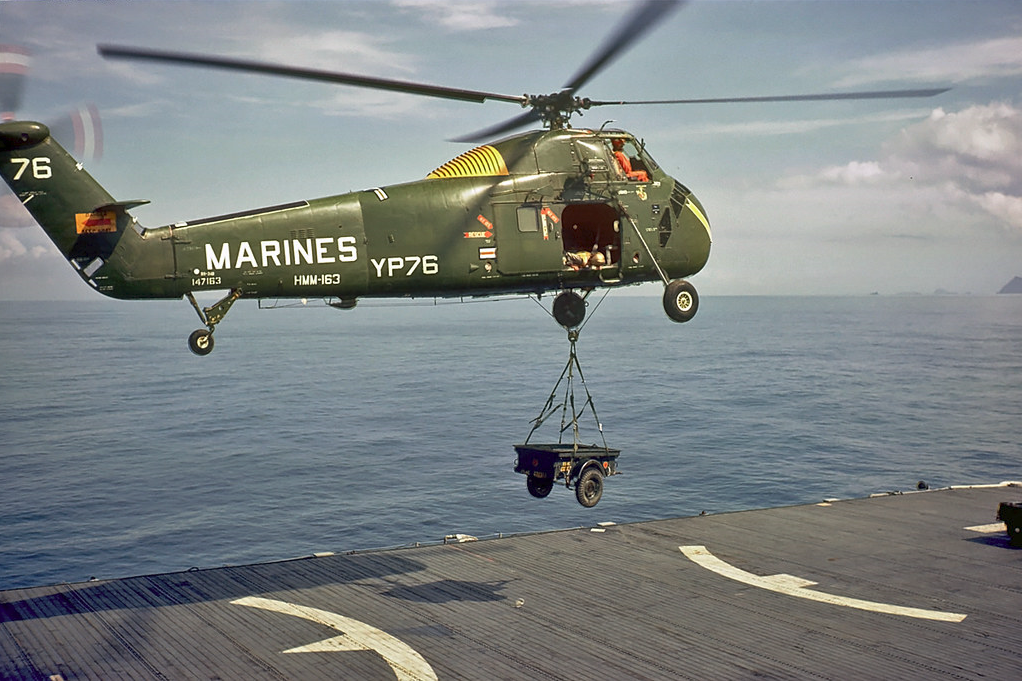
| TYPE | MFGR. | POWERPLANT | WEIGHT EMPTY | WEIGHT MAXIMUM | PERFORMANCE MAX SPEED | INITIAL CLIMB RATE | SERVICE CEILING | COMBAT RADIUS |
|---|---|---|---|---|---|---|---|---|
| UH-34D | Sikorsky | ONE (1,1525-hp) Wright R-1820-84 radial piston engine | 7,646 lb. | 11,867 lb. | 101 mph | 1,500 ft./min | 12,000 ft | 225 miles |
| ARMAMENT |
|---|
| M60 machine guns;Some had TK-2 kits installed external M60C's and 19 shot rocket pods |
This machine was a hit from the day the flrst one rolled off the production line. Relative to its predecessor helos, its performance justified its looks. It was responsive, agile, well-powered, and forgiving. It required few hours of maintenance per hour of flight time. For its time it was the ideal helicopter in reliability and performance.
Prior to the commitment of helos to combat in RVN there was considerable wonder among the aircrews as to the ability of helos to survive direct enemy fire, there being scant practical experience in this matter. The initial commitment of H-34s to assault and medevac operations proved that helos were more difficult to hit than imagined and that they could absorb a lot of damage and still fly home. That so many damaged H-34s made it home is not so much a criticism of the VC gunners… they put a lot of holes in helos and scared the hell out of a lot of aircrews… but a testament to the plane and its crews, frightened or not.
In RVN there was literally no mission to which the H-34 was not assigned, from Holy Helo (delivering chaplains to conduct services ) to emergency recon team extractions. No matter the mission or conditions, the aircraft and crews found some way to get the job done. Missions in the mountains west of the coastal plain were especially challenging since rotor and engine performance deteriorated quickly with altitude. Under these conditions an H-34 with any appreciable payload was operating at the edge of the envelope.
For many reasons, the most rewarding mission to the aircrews was probably medevac. It provided a lifesaving service to fellow Marines, often when the LZs were hot. There were a lot of nuances to doing this mission correctly; land with the helo between the medevac and the source of enemy fire so as to shield those carrying the casualty to the chopper; land as close to the medevac as possible to reduce the carrying task and exposure of the grunts to the VC. In the event of enemy fire have the escorting gunship blow up the general part of the world from whence the fire came. Flying the UH-34 “Dog" in RVN changed the meaning of the phrase, “Dog days." They were a joy to fly. H-34 pilots and aircrews hold a special place in their hearts for the “Dog."
UH-1E
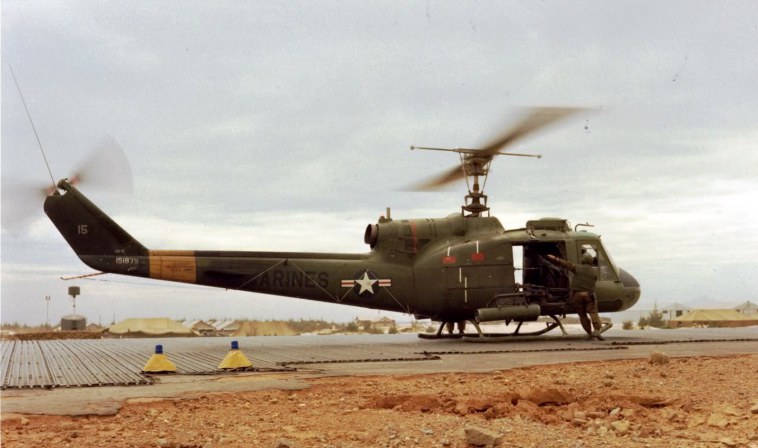
| TYPE | MFGR. | POWERPLANT | WEIGHT EMPTY | WEIGHT MAXIMUM | PERFORMANCE MAX SPEED | INITIAL CLIMB RATE | SERVICE CEILING | COMBAT RADIUS |
|---|---|---|---|---|---|---|---|---|
| UH-1E | Bell | ONE (1,100-shp) Lycoming T53-L-1 turboshaft | 4,750 lb. | 8,500 lb. | 138 mph | 2,350 ft./min | 16,700 ft | 212 miles with max fuel |
| ARMAMENT |
|---|
| 2 internal M60 and 4 external M60C machine guns with 500 rounds per gun; either 9 or 18 shot rocket pods |
The UH-IE (fondly referred to as the Huey) was an Army UH-1B to which minor modifications were applied to make it suitable for use by the Marines. Of these mods, chief were a different electrical system and radios, a rotor brake, and an aluminum fuselage. It was the first turbine powered helicopter to enter service in the FMF (Feb ’64) and was procured as a replacement for the HOK and as an assault support helicopter.
The Huey was soon to be at the center of a controversy over doctrine within the Corps regarding armed helicopters. The issue was brought to a head by unique limitations imposed in prosecuting the war in RVN. It included the increased success of the VC in shooting up unescorted transport helos in LZs, and the increasing reliance of Marines on armed Army helos as escorts during operations into hot LZs.
In order to control costs, Bell had built the initial order of the Huey exactly like the Army UH-1Bs except for changes specified by the Corps. As a result, all the features required to fully arm the Army version were built into the Marine UH-1Es. Thus, once a decision to use the Huey for armed helicopter support was made, this cost control measure greatly expedited the conversion of a portion of the Huey fleet into gunships.
There were never sufficient Marine gunships in RVN to fulfill all the missions requested of them. Medevac escort, recon team inserts and extractions, assault operations, direct fire support of engaged Marine ground units, TACA duties, and convoy escort, as well as other missions flying Huey ‘slicks" had VMO aircrews overcommitted throughout their entire tours. If ever the Marine Corps got its money’s worth out of any aircraft and aircrews, it was these.
Few summaries of the Huey in RVN ever spent much space on its non-gunship missions such as reconnaissance, VIP and passenger transport, command & control, and medevac, in part, because gunship missions were more exciting and these other missions were frequently assigned to other helos.
CH-46
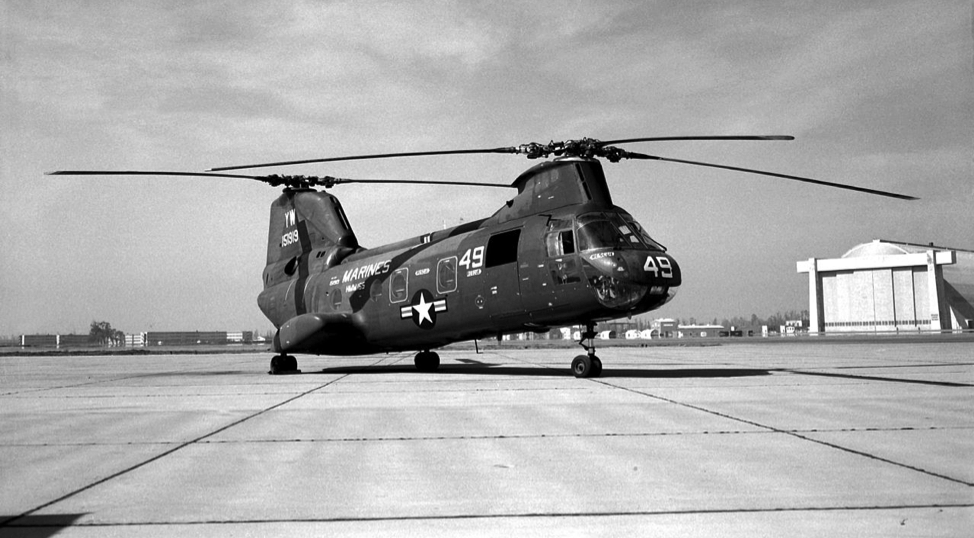
| TYPE | MFGR | POWERPLANT | WEIGHT EMPTY | WEIGHT MAXIMUM | PERFORMANCE MAX SPEED | INITIAL CLIMB RATE | SERVICE CEILING | COMBAT RADIUS |
|---|---|---|---|---|---|---|---|---|
| CH-46 | Boeing | TWO (1,400-shp)General Electric T58-GE-10 turboshafts | 13,067 lb. | 23,000 lb. | 161 mph | 1,660 ft./min | 14,000 ft | 236 miles at max weight and 10% fuel reserves |
| ARMAMENT |
|---|
| .50 cal machine guns |
For as far back as anyone could remember, the FMF had always been near totally equipped with Sikorsky helicopters (there had been a few HTL-4s in Korea and the HOKs were stateside in the late 1950s). There was shock and disbelief when it was announced that the replacement for the UH-34D would be the Boeing Vertol CH-46 and not the competing Sikorsky design. Nicknamed “The Frog" due to its posture and appearance on the ground, the CH-46 was anything but frog-like in the air. As the new primary assault helo it brought a greatly increased payload, cruising air speed, and ease of loading/unloading people and cargo while retaining all of the UH-34’s virtues.
As quickly as aircrews and maintenance people could be adequately trained, Frogs were deployed to RVN replacing the UH-34s in country. All went smoothly until a series of catastrophic accidents in 1967 resulted in the H-46s being grounded. They flew only on emergency operations in RVN which could not be flown by other aircraft. Many of these accidents involved the chopper coming apart in flight, and it is easy to imagine how aircrews felt when dispatched on flights before the cause of these accidents were determined and corrective actions taken..Even so, not one needed sortie was missed.
While the Frog distinguished itself throughout its service in RVN, surely the battles around Khe Sanh and its outposts were high points. In generally bad weather and from bases near the coastline, CH-46s shuttled throughout the mountainous Khe Sanh area. They constantly moved medevacs, people, and supplies as the tactical situation required, often under IFR conditions, all the while being strenuously opposed by North Vietnamese Army regulars… all pretense of indigenous VCs with home-made weapons had long since vanished. Operations around Khe Sanh took place over a prolonged period, severely taxing the endurance of aircrews and maintenance people. That the NVA finally packed up and withdrew was due in no small part to the CH-46, her steadfast aircrews, and those who supported both.
First delivered to the FMF in 1964, the Frog was still serving over 30 years later… the Corps’ primary assault chopper.
CH-53
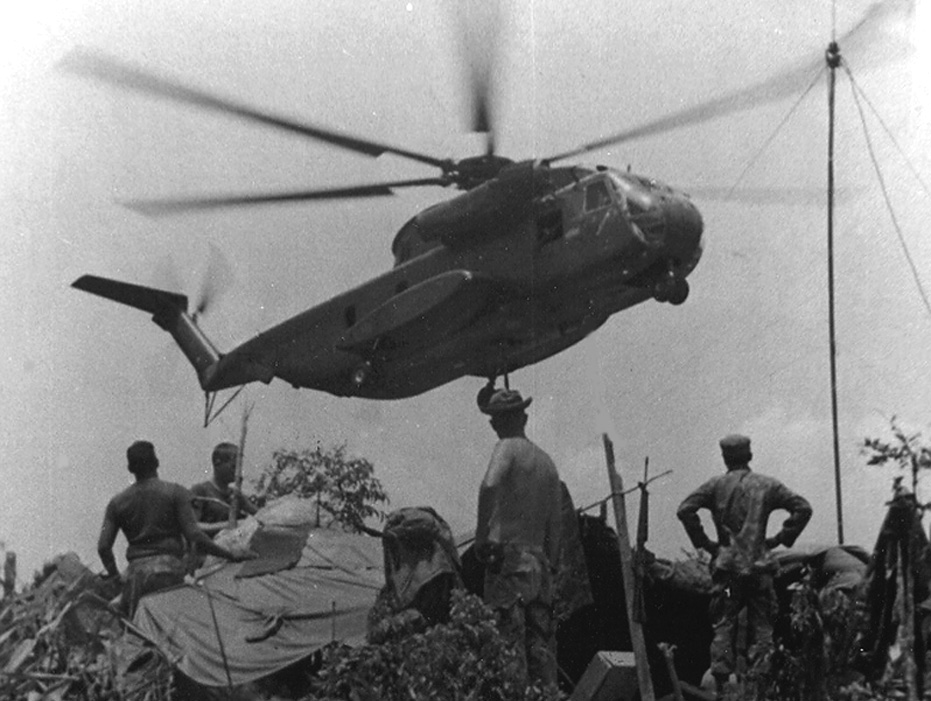
| TYPE | MFGR. | POWERPLANT | WEIGHT EMPTY | WEIGHT MAXIMUM | PERFORMANCE MAX SPEED | INITIAL CLIMB RATE | SERVICE CEILING | COMBAT RADIUS |
|---|---|---|---|---|---|---|---|---|
| CH-53D | Sikorsky | TWO 4,380 shp General Electric T64-GE-416 engines | 23,485 lb. | 42,000 lb. | 196 mph at S/L | 2,180 ft./min | 21,000 ft | 257 miles with max standard fuel and 10% fuel reserves |
| ARMAMENT |
|---|
| .50 cal machine guns |
In many ways the CH-53 is the ideal helicopter which all the early Marine Corps vertical envelopment planners had in mind when initially conceiving Marine Corps requirements for a large helicopter capable of moving large amounts of troops or supplies. It has power to spare; passengers and cargo are easily accommodated in large quantities; it is stable, maneuverable, long range, all-weather, and the cockpit is actually comfortable. Everything on the helo except the seat belts are hydraulically boosted.
First delivered to the FMF in 1966, the H-53 made it to RVN just as the final few Deuces were breathing their last gasps. Once there, the H-53 began establishing records as people and cargo haulers and became familiar all over I Corps wherever there was heavy hauling to be done.
Originally designed as a heavy logistic transport, transporting heavy internal cargo, or outsize external cargo such as artillery, vehicles, or downed aircraft, the 53 had not been involved in the combat assault or “strike" mission. This changed as ground commanders realized that 50 Marines landed aboard 3 or 4 aircraft delivered a greater amount of combat power into the LZ much faster. 463 participated in the USMC’s largest combat assault to date in 1970, when 12 CH-53s joined another 24 plus CH-46s to land nearly a thousand Marines in a night assault south of Marble Mountain in an attempt to seal off and capture NVA and VC leaders who were meeting in the area.
Similar operations succeeded in forcing the NVA northward along the coastal plain until the province capital of Quang Tri was liberated. During the last such operation a CH-53 carrying troops in the assault became the first Marine helo known to be shot down by a guided missile. Its starboard engine was blown off by a heat-seeking SA-7. It continued in flight on the port engine until it reached the LZ where it crash landed, with its final mission accomplished and its aircrew becoming unanticipated reinforcements for the assault troops.
GUNSHIPS
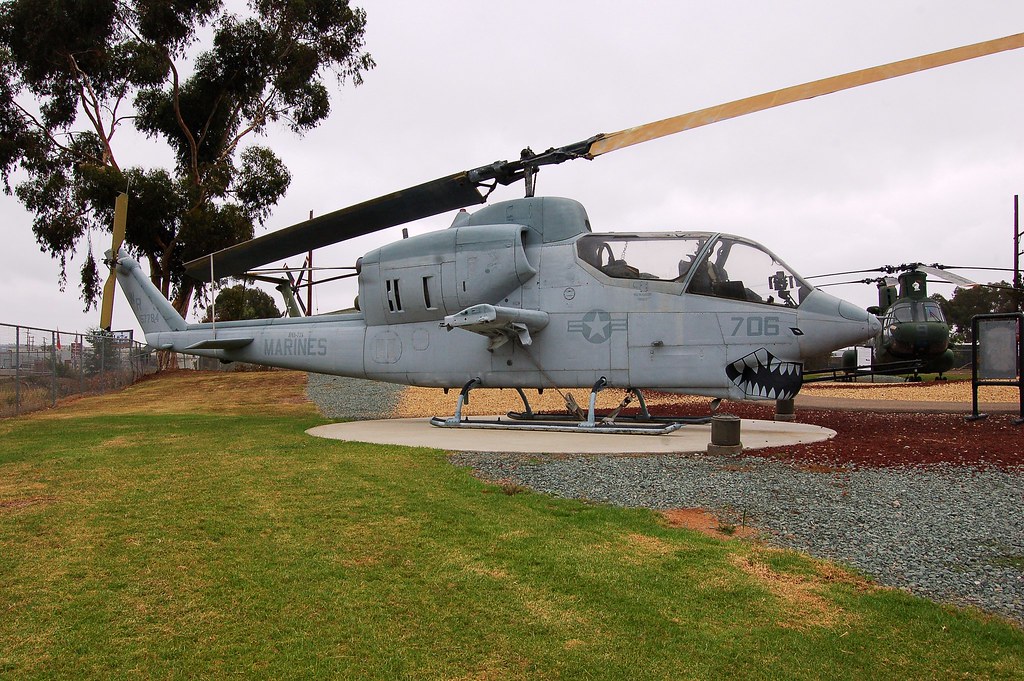
| TYPE | MFGR. | POWERPLANT | WEIGHT EMPTY | WEIGHT MAXIMUM | PERFORMANCE MAX SPEED | INITIAL CLIMB RATE | SERVICE CEILING | COMBAT RADIUS |
|---|---|---|---|---|---|---|---|---|
| AH1-G | Bell | ONE (1,800-shp) Lycoming T53-L-703 turboshaft | 6,598 lb. | 10,000 lb. | 141 mph | 1,620 ft./min | 12,200 ft | 305 miles with max fuel and reserves |
| ARMAMENT |
|---|
| one General Electric turret for 20mm cannon and hard points for up to 72 2.75 in rockets |
As early as spring of 1949 the Corps had conceived of using helos firing rockets in an anti-tank role, and by 1951 HMX-1 had tested the mounting and firing of machine guns and 2.75 inch rockets from an HTL-4.
The instability and limited development of armed helicopters was not stopped, neither did it become a front burner project. It was to be a long and winding road from these early efforts to the Corps’ first fully capable and deadly gunship.
Contrary to opinions which became popular among early gunship advocates, there were valid, practical reasons for this delay. Instability and limited lift capability were engineering problems more easily solved than other issues. The combination of budget limitations and force structure provided CMC with more difficult choices. The budget limited the number of squadrons and airframes. If you want two squadrons of gunships, give up two squadrons of attack aircraft. The Corps had to be prepared to respond to a variety of threats all over the world, and the inter-related issues of force structure and doctrine were based on this. It was not at all obvious that swapping attack aircraft for the gunships which could be developed at that time would be a smart action to take.
The Vietnam war provided both impetus and solution to gunship development. Budget constraints relaxed which resulted in the availability of funds for development and hardware. By 1963 combat damage and losses of H-34s grew to the point that Army UH- IB gunships were called in to escort them on most missions. By 1964 even this escort was not adequate and the Corps developed a kit of two rocket pods and two machine guns to convert some H-34s to gunships, a mission for which this model helo proved unsuited. A late 1963 proposal to arm the UH-1E had run aground on controversy over using helos as attack aircraft. In late 1964 this problem was resolved by specifying that arming the UH-1E was for self-defense. A month later, after the program was underway, it was expanded to include escort missions. By such devious means the UH-IE became a superb gunship, so the gunship concept was slipped into the FMF, there to remain.
In comparison with today’s gunships the UH-1E was primitive. On each side it carried a rocket pod and two fixed M-60 machine guns. The crew chief and gunner each had a swivel mounted M-60 to provide fire abeam of the helo. In moments of great excitement the copilot could, and occasionally did, fire his revolver out the left cockpit window. The gun sight was a swing-up, swing-down rod on the end of which was a metal ring containing a pair of wires which crossed in the center. This was lined up with a grease pencil dot on the windscreen. The dot showed where, more or less, the forward fired ordnance would hit the target. Simple, basic, and deadly, the UH- I E gunship proved the concept beyond any doubt and paved the way for the AH- I gunship series which followed.
It is sort of fitting that even as the Flash Gordon fighters of today can trace their origins to WWI pilots shooting pistols, rifles and throwing bricks at each other, so also can the current gunships… which can eat up a whole column of tanks for breakfast… trace their lineage to hyped up copilots with pistols, firing out the side windows and gunsights based on grease pencil marks.
O-1E Birddog
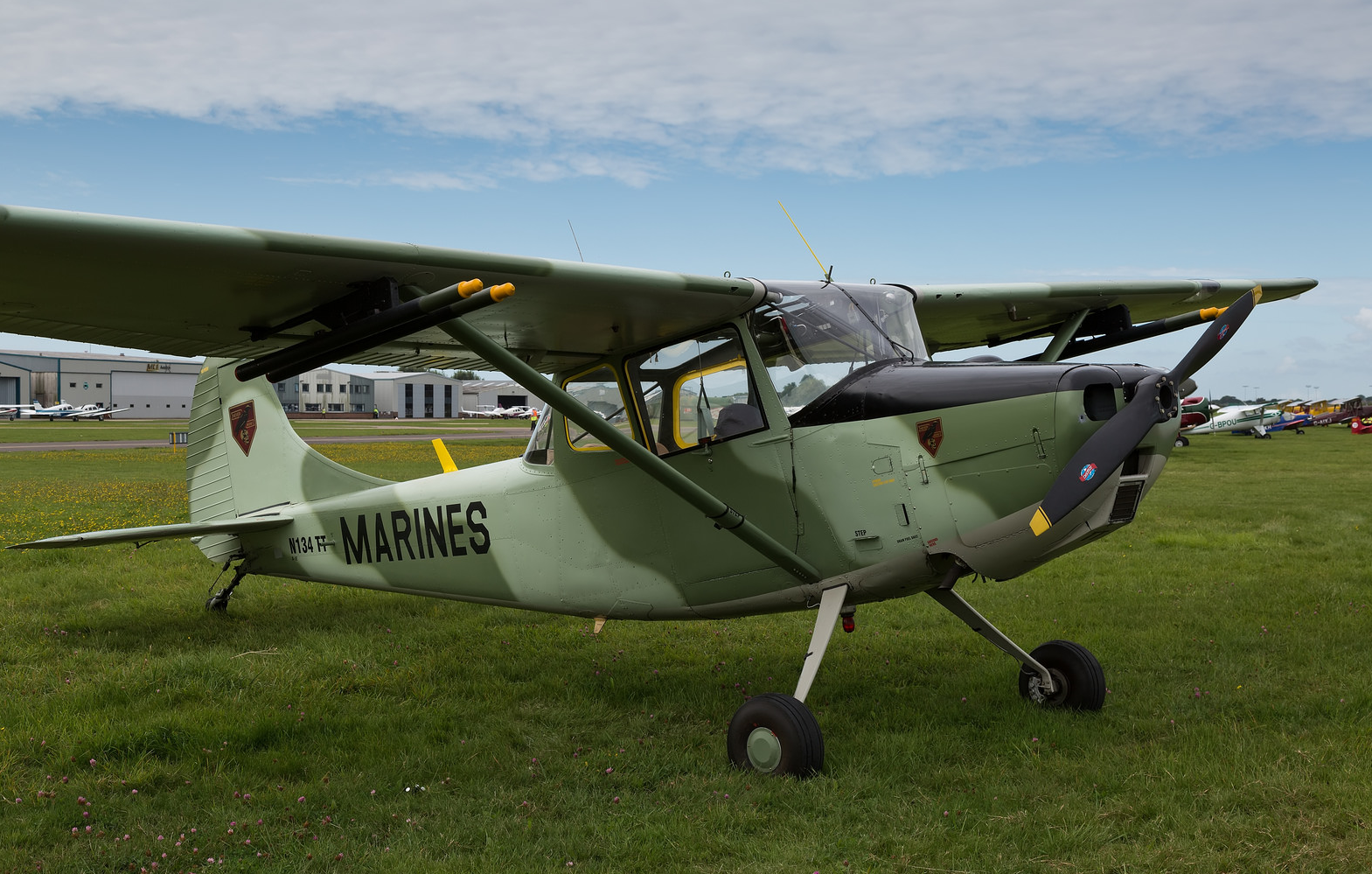
| TYPE | MFGR. | POWERPLANT | WEIGHT EMPTY | WEIGHT MAXIMUM | PERFORMANCE MAX SPEED | INITIAL CLIMB RATE | SERVICE CEILING | COMBAT RADIUS |
|---|---|---|---|---|---|---|---|---|
| O1-C | Cessna | ONE (265-hp) Continental O-470-2 piston | 1,614 lb. | 2,430 lb. | 131 mph | 1,485 ft./min | 18,500 ft | 305 miles with max fuel and reserves |
| ARMAMENT |
|---|
| Four hard points for 2.75" white phosphorus or smoke rockets |
The 0-1 a/c, aka Birddog, was a Cessna C-170 except that it had additional radios and a two-man crew, consisting of a pilot in the front seat and an artillery observer in the rear seat, seated fore-and-aft. The B model had a fixed-pitch-prop and the C model had a variable-pitch-prop.
Both were flown in the Korean War and the Viet Nam War as a spotter for artillery or fixed-wing a/c and to lead helicopters to a landing zone.
In Viet Nam, the 0-1 a/c was flown by the USMC, USA, and the USAF.
OV-10 Bronco
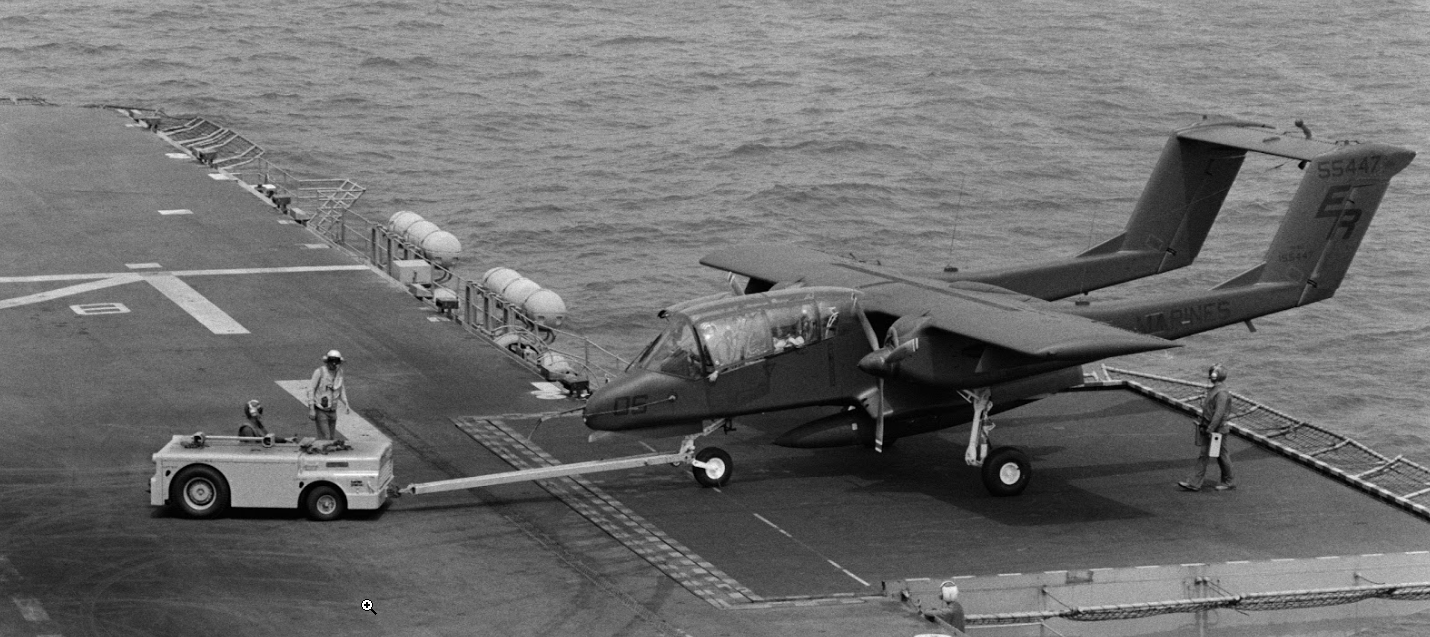
| TYPE | MFGR. | POWERPLANT | WEIGHT EMPTY | WEIGHT MAXIMUM | PERFORMANCE MAX SPEED | INITIAL CLIMB RATE | SERVICE CEILING | COMBAT RADIUS |
|---|---|---|---|---|---|---|---|---|
| O1-C | Cessna | ONE (265-hp) Continental O-470-2 piston | 1,614 lb. | 2,430 lb. | 131 mph | 1,485 ft./min | 18,500 ft | 305 miles with max fuel and reserves |
| ARMAMENT |
|---|
| Four hard points for 2.75" white phosphorus or smoke rockets |
TThe OV-10 Bronco was a multi-purpose, light attack aircraft acquired by the Marine Corp for observation squadrons to conduct visual reconnaissance missions. The OV-10A is a twin-turboprop short takeoff and landing aircraft conceived by the Marine Corps and developed under an Air Force, Navy, and Marine Corps tri-service program. The first production OV-10A was ordered in 1966 and its initial flight took place in August 1967. The OV-10 can be used for short take-offs and landings on aircraft carriers without the use of catapults. With the second seat removed, it can carry 3,200 pounds of cargo, five paratroopers or two litter patients and an attendant. Adding to its versatility is a rear fuselage compartment with a capacity of 3,200 pounds of cargo, five combat-equipped troops, or two litter patients and a medical attendant.
The Bronco’s mission capabilities include observation, forward air control, helicopter escort, armed reconnaissance, gunfire spotting, utility and limited ground attack; however, the USAF acquired the Bronco primarily as a forward air control (FAC) aircraft. The Bronco also provides transportation for aerial radiological reconnaissance, tactical air observers, artillery and naval gunfire spotting and airborne controllers of tactical air support operations. Other tasks include armed escort for helicopters and front line, low-level aerial photography.
Each of the Marine Corps’ two observation squadrons had 18 aircraft, 9 OV-10As and 9 OV-10Ds night observation aircraft. There was also a Marine Air Reserve squadron. The OV-10 was phased out of the Marine Corps in 1995.
The OV-10 Night Observation Gunship (NOGS) was a USMC OV-10A modified to include a turreted FLIR sensor and turreted M-197 20-mm gun slaved to the FLIR aimpoint. Successful in combat in Vietnam, NOGS evolved into the NOS OV-10D, which included a laser designator.
Although the United States no longer flies the OV-10, other countries continue to operate the Bronco.
